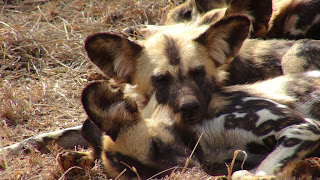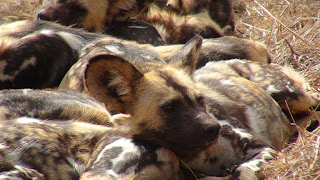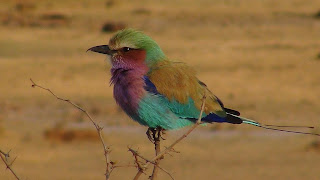In 1997, Doug and I traveled to Africa for the first time,
and on that trip we did an overland (i.e. camping) safari in Botswana. We spent
nine days with a small group of people and a guide exploring northern Botswana
and the Okavango Delta. It was an amazing experience, and we immediately decided
we wanted to do it again. Two years later, we were back, this time staying in a
variety of tented camps and lodges throughout the delta, and we loved it even
more. Over the next decade, we returned to southern Africa five more times and
explored camps in South Africa and Namibia as well, but the Okavango Delta was
the place we loved the most.
We always planned to bring Carter to Africa as soon as he
was old enough to go on safari – which is generally considered to be 8 or 9
years old, and in some places, 12. But we couldn't bear the idea of traveling
through Africa and not having some sort of safari experience, and so last fall
Doug began a long search for camps and lodges throughout southern Africa where
we could realistically and safely take a five-year-old on safari. He found a
total of three that said they would take small children, and we decided to go
to all of them. Jaci's Camp in Madikwe, South Africa, was the first of these.
It was unclear from the camp's website whether or not Carter
would be able to go on game drives (the main activity in a safari camp) or even
if he'd be able to eat dinner with us, but at least the camp was advertised as
being child-friendly, so we were hopeful. We flew from Capetown to Johannesburg
and then were driven to Madikwe, a very large wildlife reserve four hours to
the north. We arrived and were excited to find that the camp looked like any
other safari camp we've been to before, with a large open-air main lodge area
and tents built up on platforms (with electricity and running water, of course),
but unlike the others we've stayed in, it is surrounded by an electric fence.
The camp also had a play area for kids with lots of toys and even a small playground,
to our (and Carter's) delight.
We also found that first night that Carter could go with us
on game drives, something we'd been uncertain about. We were a bit nervous
about his ability to sit on an open vehicle for several hours a day, while we drove
around looking for animals, but he surprised us almost immediately by settling
right into this new routine. I think he
really enjoys riding around in an open vehicle and being able to snuggle on
Mommy and Daddy whenever he wants. His attention span varies from drive to
drive, and we finally started bringing the iPad for him just in case he got
bored. Game drives are not the most
kid-friendly activities: there is a lot of driving around and looking for
animals that can be surprisingly difficult to see – and once you finally do find
them, you often have to be very still and quiet. As you can imagine, with a
small child, that could be a recipe for disaster. But Carter, as usual, settled right in. He
would typically watch the scenery go by for an hour, then play with his ipad
for a bit, and then when we found an animal, he'd be ready to stop playing and
look, and talk about the animal and what's it's doing and so on. It's worked
out much better than Doug and I even hoped it would.
We spent the first half of our week at Madikwe with a lovely
family from Dubai. They had three children, the youngest of whom was Carter's
age, and Carter really enjoyed being around other kids. Our guide, Declan, was
fantastic with the kids, which made a big difference. After they left the camp,
we decided to pay a little extra for a private vehicle for the rest of the
week, and so we had Declan all to ourselves. That allowed us to be a bit more
flexible, and we had a lot of fun.
The typical safari camp schedule is that you get up at dawn,
have a light breakfast, and then head off for a morning game drive. There is a
tea stop in the middle (which is probably Carter's favorite part – he really
enjoys getting to walk around and pick up sticks and such) and then you return
to camp around 10:30 or so for brunch. From then, it's free time until 3:30,
when afternoon tea is held, followed by an afternoon game drive. There is
another stop then for sundowners, and then everyone returns to camp shortly
after nightfall. Then there is dinner, and then you head off to get to sleep
early in preparation to get up the next morning and do it all again. Carter is typically not a morning person, but
he adjusted quickly to the new schedule, and really seemed to enjoy going out
on drives.
Below are some photos of the animals we saw over the course of the week. Impala are a very common antelope in southern Africa. They're sleek, beautiful animals.
One of the largest antelope in southern Africa is the Greater Kudu. The males have very distinctive spiral horns. I learned on this trip that a major difference between antelope and deer is that antelope don't shed their horns the way deer shed their antlers every year.
Madikwe has quite a few blue wildebeests.
Giraffes are always such a pleasure to see. They're so tall and graceful, and when they run, it looks like they're moving in slow motion.
Madikwe has a pack of wild dogs, another highly endangered
animal. Wild (or painted) dogs are a completely different species from domestic
dogs, and they're really beautiful. This particular pack had puppies, and we
got to see them several times. We didn't
see these dogs doing much but lying around, but they are very efficient hunters
and kill impala nearly every day.
Zebras are so beautiful! I always enjoy seeing them.
Here we are stopping for a mid-morning tea break.
The stops were some of Carter's favorite times of the game drives. He loved getting off the vehicle and having a chance to walk around on the ground, pick up sticks, and check out bugs. Here he's checking out a large termite mound.
More wildebeest and zebra shots. These animals are often found together.
And we saw lots of elephants, of course! The elephants in Madikwe are a little more aggressive than elephants in some of the other places we've visited, which was interesting.
We were fortunate to get see see several lions during our week in Madikwe.
This is basically the way you see lions 90% of the time. They are typical cats and sleep 20 hours a day.
This one was even sleeping on his kill.
It's a bit rare to see a scrub hare during the day.
And this is perhaps the rarest thing we've ever seen: an aardvark during the day! They're nocturnal and extremely shy, so it's hard enough to see one at night, but to see one during the day is simply unheard of!
Black-backed jackal.
And more elephants.
Since we had a private vehicle for half the week, we could
change up the usual schedule a bit, and so one day we decided to go on an
all-day game drive. We were a little
worried that this might be too much for Carter, but he did just fine (with the
help of the ipad, of course). We left
mid-morning and drive a long way, further than we were able to go during a
normal game drive, and so we got to see more of the reserve. The reserve itself
is huge and it would be impossible to see all of it even in a week! We stopped
around the middle of the day for a brai (a BBQ) in the bush, which was a lot of
fun. Carter enjoyed having a chance to get off the vehicle and play for a
while.
We were able to visit a few watering holes in the middle of the day when the animals come to have a drink. It's amazing to see so many animals there all at the same time. The predators tend not to be active in the middle of the day, so most of the animals were fairly relaxed.
Most of the water holes in Madikwe are artificial (since the reserve is fenced in), and so each water hole has a pump. The elephants seem to prefer drinking the water fresh from the tap!
We saw a few ostriches during our day drive. This was the only time we saw wild ostriches on this trip.
We visited some lions with a wildebeest kill on this day too. There were two lionesses and four or five cubs.
This is a haartebeest, an antelope we weren't sure we've seen before this trip.
On another day, we left Carter at camp with a babysitter and went on a walking safari. This turned out to be very exciting because we saw a black rhino on our walk! We didn't get a photo because we were too busy making sure it didn't see us.
More wild dog pictures. These are the puppies.
They really are beautiful animals.
Carter got to ride up front with Declan one morning, which he seemed to enjoy.
We saw lots of animals, of course, but a highlight for us
was that Madikwe has both white and black rhinos. Rhinos are being heavily
poached all over Africa (due to a renewed high demand for rhino horn in China,
mostly), and it's really a horrible thing. These animals are highly endangered,
and they're illegally slaughtered by people who cut off their horns (which are
made of keratin, same as your fingernails) and smuggle them out of the country
to sell for insane amounts of money in China. We even heard reports while here
that Chinese diplomats had been caught with rhino horns and pleaded diplomatic
immunity, and so were never prosecuted. The suspicion is that some diplomats
are smuggling them out of the country in the special diplomatic pouches that
can't legally be opened by customs in other countries.
In a decade, these animals might be extinct, simply because
some people in Asia think that powdered rhino horn will cure their erectile
dysfunction and are willing to pay poor and desperate people ridiculous amounts
of money to procure it for them. It's utterly tragic.
We saw two black rhinos, but since they are incredibly
elusive, we didn't get any photos of them. We saw many white rhinos, including
this mother and calf.
In this picture, you can see the mother rhino and calf in the background and a spotted hyena in the foreground.
The incredibly beautiful lilac-breasted roller.
On another morning, we heard lions calling nearby and set out to find them. We finally found this young male.
We also got to hear him calling the other lions, which is such an amazing experience. The video below was edited together from the videos we took during the week, and you can hear the lion roaring in it.
Here we are on our last day with Declan. He was a fantastic guide and we had so much fun with him! We hope to go back to Jaci's Camp in the next few years, and if Declan is still guiding there, we will look forward to seeing him again.
We didn't have internet while we were there, and basically didn't have internet for the next few weeks after that, and so I have several weeks of posts to catch up on. We're currently overnighting in London on our way to Romania (where Doug has a conference), and so I'm hoping to make a few more posts then.















































































Amazing pictures. This is one part of your trip I'm really envious about. I didn't know you there were places where you could have younger children on Safari. The electric fence would go a long way to helping me sleep better w/ Alex there. So cool!
ReplyDelete- Kara